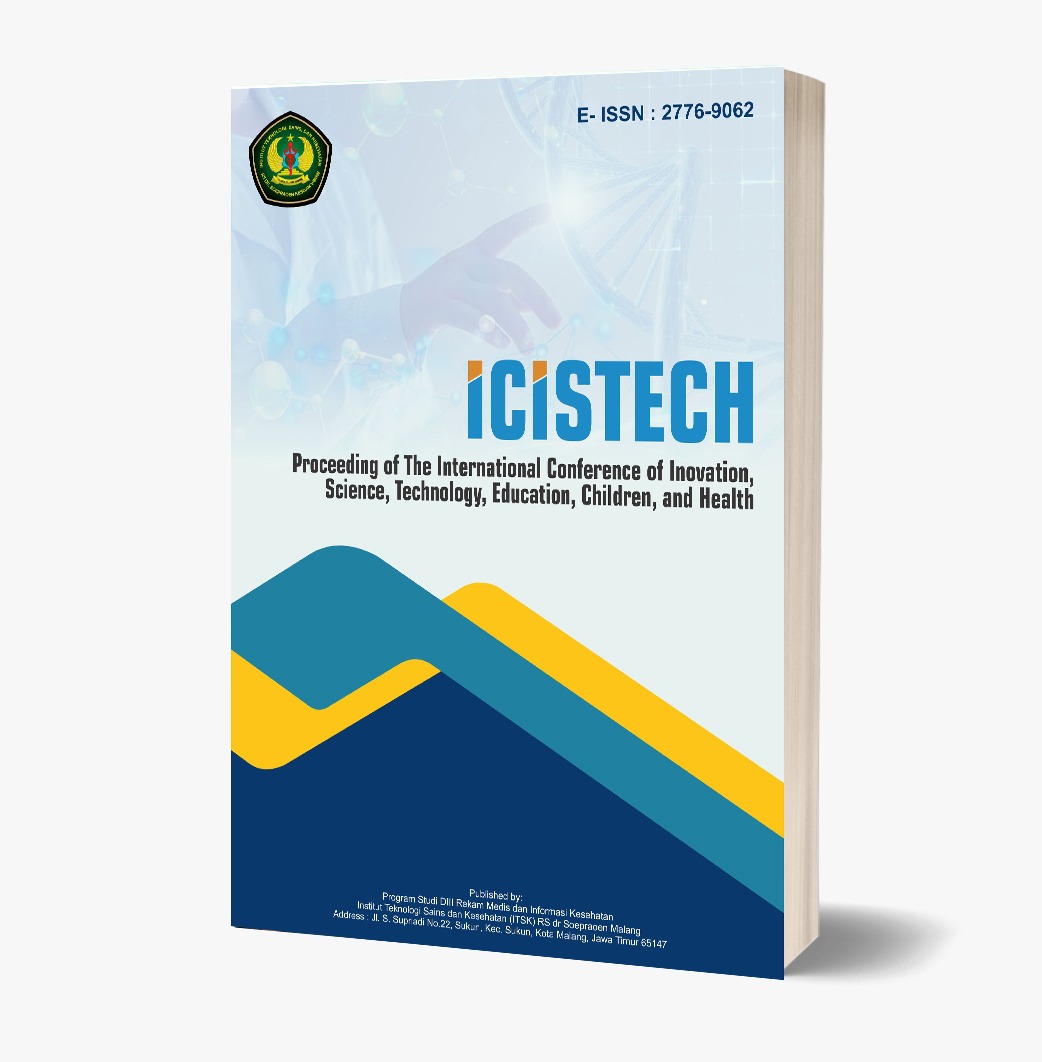Nutritional Status and Cognitive Function in the Adolescent’s Rapid Growth Phase between 12-14 Years Old
DOI:
https://doi.org/10.62951/icistech.v3i2.62Keywords:
adolescent, cognitive, nutritionalAbstract
Adolescence is a period of transition from childhood to adulthood. One of the transitions is the cognitive aspect of thinking ability. Poor nutritional status can harm children's growth and development. The factors that influence cognitive development are the nutritional status that affects adolescent intellectual development. The relationship between the nutritional status and the cognitive function in the adolescent’s rapid growth phase between 12-14 years old is not clear. This study aims to identify the relationship between the nutritional status and the cognitive function in the adolescent’s rapid growth phase between 12-14 years old. This study used observational analytical design and a cross- sectional approach with an adolescent group population of 12-14 years old. The research subject was a total of 71 people. Primary data included weight and height while secondary data included MMSE-Child and questionnaires. The data were analyzed using the Chi-Square statistical test. Based on the measurement of Body Mass Index (BMI), most research subjects had a normal nutritional status with a total of 32 people (45.10%). Furthermore, 63 people (88.70%) have a normal cognitive function. There was no significant relationship between Nutritional Status and MMSE scores (p=0.454). Likewise there were no significant relationship between gender and MMSE scores (p=0.750), age and MMSE scores (p=0.255). In this study, there was no significant relationship between nutritional status and cognitive function.
References
Aisyah, E. N., Iriyanto, T., Astuti, W., & Yafie, E. (2019). Pengembangan alat permainan ritatoon tentang binatang peliharaan sebagai media stimulasi kemampuan kognitif anak usia dini. Jurnal Kajian Teknologi Pendidikan, 2(3), 174–180. https://doi.org/10.23887/jkpt.v2i3.21490
Blakemore, S.-J., & Mills, K. L. (2014). Is adolescence a sensitive period for sociocultural processing? Annual Review of Psychology, 65, 187–207. https://doi.org/10.1146/annurev-psych-010213-115202
Bleiweiss-Sande, R., Chui, K., Wright, C., Amin, S., Anzman-Frasca, S., & Sacheck, J. M. (2019). Associations between food group intake, cognition, and academic achievement in elementary schoolchildren. Nutrients, 11(11), 2722. https://doi.org/10.3390/nu11112722
Burrows, T., Goldman, S., Pursey, K., & Lim, R. (2017). Is there an association between dietary intake and academic achievement: A systematic review. Journal of Human Nutrition and Dietetics, 30(2), 117–140. https://doi.org/10.1111/jhn.12430
Caesarianna, D., & Indriawati, R. (2016). Obesitas: Hubungannya dengan pola asuh dan tingkat penghasilan orang tua pada kelompok usia 11-13 tahun. Mutiara Medika: Jurnal Kedokteran dan Kesehatan, 7(2), 82–87.
Cholifah, P. S., Oktaviani, H. I., Nuraini, N. L. S., Meidina, A. M., Wanodyaningtiyas, R. F., & Yafie, E. (2019, October). Online project-based learning for improving the innovative initiation during diffusion and innovation course. In Proceedings of the 2019 5th International Conference on Education and Technology (ICET) (pp. 55–60). IEEE. https://doi.org/10.1109/ICET47713.2019.8975460
Cockrell, J. R., & Folstein, M. F. (1988). Mini-Mental State Examination (MMSE). Psychopharmacology Bulletin, 24(4), 689–692.
De Greeff, J. W., Hartman, E., Mullender-Wijnsma, M. J., Bosker, R. J., Doolaard, S., & Visscher, C. (2016). Long-term effects of physically active academic lessons on physical fitness and executive functions in primary school children. Health Education Research, 31(2), 185–194. https://doi.org/10.1093/her/cyv102
Dudzińska, M., Neć, M., Zwolak, A., Oszywa-Chabros, A., Malicka, J., Smoleń, A., Daniluk, J., & Tarach, J. S. (2016). The role of the primary care outpatient clinic in the promotion of healthy nutrition – preliminary reports. Family Medicine & Primary Care Review, 18(3), 230–234. https://doi.org/10.5114/fmpcr/63408
Eilander, A., Gera, T., Sachdev, H. S., Transler, C., van der Knaap, H. C., Kok, F. J., & Osendarp, S. J. (2010). Multiple micronutrient supplementation for improving cognitive performance in children: Systematic review of randomized controlled trials. American Journal of Clinical Nutrition, 91(1), 115–130. https://doi.org/10.3945/ajcn.2009.28376
Gómez-Pinilla, F. (2008). Brain foods: The effects of nutrients on brain function. Nature Reviews Neuroscience, 9(7), 568–578. https://doi.org/10.1038/nrn2421
Gómez-Pinilla, F. (2008). Brain foods: The effects of nutrients on brain function. Nature Reviews Neuroscience, 9(7), 568–578. https://doi.org/10.1038/nrn2421
Gómez-Pinilla, F., & Tyagi, E. (2013). Diet and cognition: Interplay between cell metabolism and neuronal plasticity. Current Opinion in Clinical Nutrition & Metabolic Care, 16(6), 726–733. https://doi.org/10.1097/MCO.0b013e328365aae3
Haapala, E. A., Eloranta, A. M., Venäläinen, T., Schwab, U., Lindi, V., & Lakka, T. A. (2015). Associations of diet quality with cognition in children—the Physical Activity and Nutrition in Children Study. British Journal of Nutrition, 114(6), 1080–1087. https://doi.org/10.1017/S0007114515001634
Haapala, E. A., Eloranta, A. M., Venäläinen, T., Schwab, U., Lindi, V., & Lakka, T. A. (2015). Associations of diet quality with cognition in children—the Physical Activity and Nutrition in Children Study. British Journal of Nutrition, 114(6), 1080–1087. https://doi.org/10.1017/S0007114515001634
Isaacs, B. E., Gadian, D. G., Sabatini, S., Chong, W. K., Quinn, B. T., Fischl, B. R., & Lucas, A. (2008). The effect of early human diet on caudate volumes and IQ. Pediatric Research, 63(3), 308–314. https://doi.org/10.1203/PDR.0b013e318165f8e8
Kilford, E. J., Garrett, E., & Blakemore, S.-J. (2016). The development of social cognition in adolescence: An integrated perspective. Neuroscience & Biobehavioral Reviews, 70, 106–120. https://doi.org/10.1016/j.neubiorev.2016.08.016
Kilford, E. J., Garrett, E., & Blakemore, S.-J. (2016). The development of social cognition in adolescence: An integrated perspective. Neuroscience & Biobehavioral Reviews, 70, 106–120. https://doi.org/10.1016/j.neubiorev.2016.08.016
Kristjansson, A. L., Sigfusdottir, I. D., & Allegrante, J. P. (2010). Health behavior and academic achievement among adolescents: The relative contribution of dietary habits, physical activity, body mass index, and self-esteem. Health Education & Behavior, 37(1), 51–64. https://doi.org/10.1177/1090198107313481
Nyaradi, A., Li, J., Hickling, S., Foster, J., & Oddy, W. H. (2013). The role of nutrition in children’s neurocognitive development, from pregnancy through childhood. Frontiers in Human Neuroscience, 7, 97. https://doi.org/10.3389/fnhum.2013.00097
Palsetia, D., Rao, G. P., Tiwari, S. C., Lodha, P., & De Sousa, A. (2018). The Clock Drawing Test versus Mini-Mental Status Examination as a screening tool for dementia: A clinical comparison. Indian Journal of Psychological Medicine, 40(1), 1–10. https://doi.org/10.4103/IJPSYM.IJPSYM_244_17
Patton, G. C., Sawyer, S. M., Ross, D. A., Viner, R. M., & Santelli, J. S. (2016). From advocacy to action in global adolescent health. Journal of Adolescent Health, 59(4), 375–377. https://doi.org/10.1016/j.jadohealth.2016.08.002
Sherly. (2013). Factors that affect cognitive function with MMSE examination in children aged 10-12 years. Unpublished manuscript.
Smith, E. R., & Christian, P. (2018). Adolescent undernutrition: Global burden, physiology, and nutritional risks. Annals of Nutrition & Metabolism, 72(4), 316–328. https://doi.org/10.1159/000489240
Stefi. (2014). Relationship between nutritional status and learning achievement in students at SMA Negeri 1 Padang. Unpublished manuscript.
Von Stumm, S. (2012). You are what you eat? Meal type, socio-economic status, and cognitive ability in childhood. Intelligence, 40(6), 576–583. https://doi.org/10.1016/j.intell.2012.08.004
World Health Organization (WHO). (2007). Body mass index (BMI). Geneva: World Health Organization.
World Health Organization (WHO). (2007). WHO reference for child and adolescent. Geneva: World Health Organization.
World Health Organization Regional Office for the South-East Asia. (n.d.). Adolescent nutrition: A review of the situation in selected South-East Asian countries. Retrieved from https://www.who.int
Yafie, E., Nirmala, B., Kurniawaty, L., Bakri, T. S. M., Hani, A. B., & Setyaningsih, D. (2020). Supporting cognitive development through multimedia learning and scientific approach: An experimental study in preschool. Universal Journal of Educational Research, 8(11C), 113–123. https://doi.org/10.13189/ujer.2020.081316
Yafie, E., Samah, N. A., Kustiawan, U., Tirtaningsih, M. T., Astuti, W., & Haqqi, Y. A. (2020, October). Design and development of a seamless learning model to improve student performance in higher education. In Proceedings of the 2020 6th International Conference on Education and Technology (ICET) (pp. 84–89). IEEE. https://doi.org/10.1109/ICET51181.2020.9309463
Yafie, E., Samah, N. A., Mohamed, H., & Haqqi, Y. A. (2020). Collaborative mobile seamless learning (CMSL) based on Android apps to improve critical thinking in higher education in the post-COVID-19 era. Journal of Advanced Research in Dynamical and Control Systems, 12(7), 428–441. https://doi.org/10.5373/JARDCS/V12I7/20202042
Downloads
Published
How to Cite
Issue
Section
License
Copyright (c) 2023 Proceeding of The International Conference of Inovation, Science, Technology, Education, Children, and Health

This work is licensed under a Creative Commons Attribution-ShareAlike 4.0 International License.













